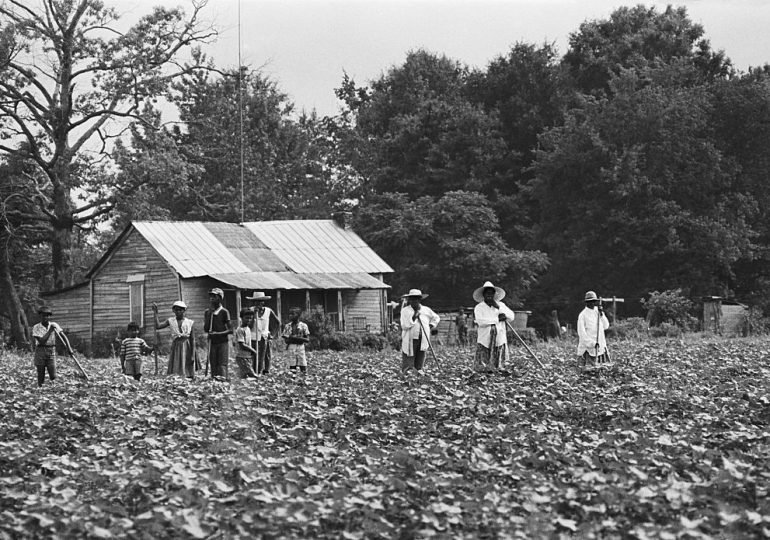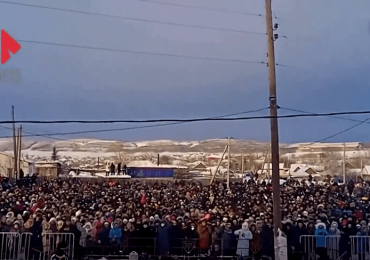Eighty-three-year-old Corine Woodson is poised to suffer a devastating blow: the loss of the home she shared with her late husband—who died in 2022—for over 60 years.
Her land, 40 acres set amid rolling pines outside of Auburn, Ala., was purchased in 1911 and passed down through generations, a rare example of Black land ownership in the Deep South. But in recent years, this once rural property, now parsed out among various family members in a form of ownership known as “tenants in common,” has caught the attention of investors who hope to purchase and develop properties they consider prime real estate. Cleveland Brothers Incorporated bought out Woodson’s relatives, accumulating 49% ownership of the previously Black-owned property. Now, the case is making news as it heads toward the Alabama Supreme Court, with the company declaring that it will suffer “financial harm” if Woodson delays the sale of her share. (A representative of Cleveland Brothers told WTVM that Woodson could stay on the property for a year even if the sale goes through.)
[time-brightcove not-tgx=”true”]
Soon, Cleveland Brothers will probably purchase the remaining property, displacing Woodson. “It’s happening right before our eyes,” Melissa Woodson, Corine’s daughter and a licensed realtor said, “and the sad thing is that there is very little we can do about it.”
Stories like Woodson’s have been common for Black residents of the rural South for more than a century. The continuation of patterns of Black land dispossession exposes how—for all of the civil rights gains made over the last 60 years—there is still much to be done to secure racial equality in the U.S.
At the turn of the 20th century, Black landowners owned and operated 890,000 farms. Around midcentury, however, that number began to decline sharply. Beginning in 1950, they lost more than half a million farms; by 1970, only 45,000 remained. During the 1960s alone, the Black farm count in 10 southern states dropped by 88%.
Read More: The Forgotten School Integration Story that Challenges What We Think We Know
This drop off reflected how, for decades, wealthy white people utilized the power they held in their communities as government officials and business owners to push local Black people off land that their families had lived on for generations. Local white people also exploited new laws and subsidies to remove landowners or renters, deploying what an Emergency Land Fund report in 1974 described as, “a great deal of chicanery.” New capital-intensive farming practices also favored the wealthy, while industrial development led to corporate interest in rural tracts, driving up prices.
Rural Black women were particularly vulnerable to these threats of dispossession. Take Susie Young, for instance. Within two weeks of the death of her husband in 1955, Young received notice from the Allison Lumber Company that she had to vacate the land her family rented from them and had tended for over 20 years in Choctaw County, Ala. They considered her now incapable of maintaining the property.
One Black Perry County, Ala., woman had a similar experience. After the death of her mother in the 1950s, a nearby white landowner returned to claim the 60 acres her parents had bought decades prior claiming he “didn’t sell [her] that land.” Though the family retained counsel and provided proof of purchase, they were nevertheless pushed off their land. Black landowners often lacked formal deeds, and white judges frequently ruled against their claims.
Even as the Civil Rights Act of 1964 and the Voting Rights Act of 1965 afforded Black Americans new opportunities and greater equality in many areas of life, these laws didn’t address land loss. In fact, the 1960s introduced a massive contradiction: at the same moment Black Americans achieved political gains, they were also experiencing a quiet economic catastrophe, the result of what historian Pete Daniel calls “intended consequences.”
Of course, civil rights organizations recognized the impact of Black land loss, not only for landowners but also for sharecroppers and tenant farmers. The Student Nonviolent Coordinating Committee (SNCC), the Congress of Racial Equality (CORE), Federation of Southern Cooperatives (FSC), and regional groups, such as the Southwest Alabama Farmers Cooperative Association (SWAFCA), pushed back against white structural control and assisted Black people facing displacement.
They understood that resistance to economic exploitation was inextricably intertwined with the civil rights movement’s racial justice initiatives. In 1968, for instance, the United States Commission on Civil Rights (USCCR) conducted an investigation of land dispossession in Alabama’s Black Belt. The Commission found that rural Black men and women were pushed off land at higher rates than whites, denied protections and grants by local Farmers Home Administration (FHmA) and Agricultural Stabilization and Conservation Service (ASCS) officials, and intimidated by hostile neighbors.
Civil rights organizations and the USCCR advised stronger enforcement of federal protections against discrimination and fair access to federal programs and grants. But it was state and local offices, often run by racist whites, that controlled implementation of these programs. This structure meant that racial equality and programs to assist the poor were nothing more than “empty promises and a cruel hoax.”
Decades later, the federal government agreed. In 1997, a group of Black farmers filed a massive class-action lawsuit against the U.S. Department of Agriculture, arguing that between 1981 and 1996, the department had discriminated against them on the basis of race. The USDA denied Black farmers loans and delayed assistance, which resulted in land loss. The plaintiffs won. The decision in Pigford v Glickman and a subsequent settlement inspired a second round of filings in 2010, known as Pigford II. In his landmark opinion, District Judge Paul Friedman acknowledged that, despite the settlement, “historical discrimination cannot be undone for the broken promise to African Americans and their descendants.”
Read More: How Civil Rights Were Made—and Remade—By Black Communities In the Jim Crow South
But these struggles have gone unnoticed by most Americans. Traditional civil rights narratives have typically centered urban spaces like Atlanta, Birmingham, or Memphis. Yet even as the civil rights revolution brought significant gains to Black residents of those cities, the story was very different in rural places like Lee County, Ga., or Lowndes County, Ala. As activist Wendell Paris put it, “the civil rights movement passed over Sumter County, Alabama, altogether.” In rural spaces, the same old local white power structures continued to dominate county boards and courts, while wielding new tools to exclude and limit Black Americans. Land loss was one of these.
Rural stories of dispossession like Woodson’s—and the sobering reality that they continue to happen—challenge popular civil rights narratives. These hopeful, progress oriented arcs, reveal an American propensity for national congratulation and, as Jeanne Theoharis has contended, “place the struggle against racial inequality firmly in the past.”
And yet, white supremacist power has not disappeared. While some of its iterations remain overt, others have shapeshifted since the 1960s, adopting new rhetoric and tactics even as they wreak familiar devastation on Black lives and Black communities. Redlining, gerrymandering, harsh sentencing, and predatory lending have proliferated just as talk of colorblindness has become mainstream. Indeed, as professions of racial parity have increased so have discrepancies in outcomes, hidden and compounded by the invisible hands of racial capitalism.
In 1968, C.H. Erskine Smith, then Chairman of the USCCR’s Alabama State Advisory Committee implored: “the people of rural Alabama and the rural South must not be forgotten.” To understand the long Black freedom struggle and to seek racial justice today means that we must heed his call.
Ansley Quiros is an associate professor of history at the University of North Alabama and author of God With Us: Lived Theology and the Freedom Struggle in Americus, 1942-1976. She and Dr. Matthew Schoenbachler are currently working on a memoir with Dr. Wendell Gunn. Allie R. Lopez is Ph.D candidate in history at Baylor University, writing a dissertation on the freedom struggle in rural Alabama. Made by History takes readers beyond the headlines with articles written and edited by professional historians. Learn more about Made by History at TIME here.
Leave a comment
















